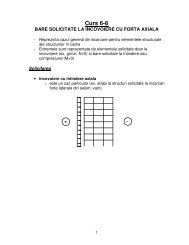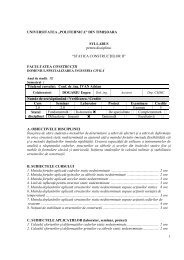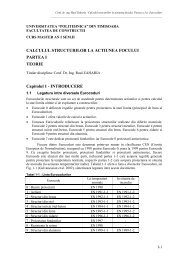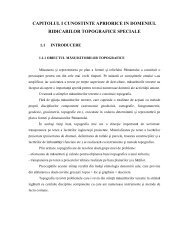- Page 1 and 2:
Pof. dr. ing. MIHAI GIURCONIU Pof.
- Page 3 and 4:
punctele extreme de consum din cent
- Page 5 and 6:
În funcţie de substanţele minera
- Page 7 and 8:
6 Indicatori fizici Indicatori Valo
- Page 9 and 10:
17 -maxim 800 1200 Seleniu (Se 2+ )
- Page 11 and 12:
20 Iod 131 5 530 STAS 12218-84 Cesi
- Page 13 and 14:
vizibile cu ochiul liber Organisme
- Page 15 and 16:
22 k i o Qo max i Q i zi max
- Page 17 and 18:
Coeficientul de variaţie zilnică
- Page 19 and 20:
26 100.001- 200.000 2 30 40 200.001
- Page 21 and 22:
28 Durata pentru refacerea rezervei
- Page 23 and 24:
- funcţionarea cu o singură surs
- Page 25 and 26: STAS 1628/1-87: - studii geologice,
- Page 27 and 28: Determinarea caracteristicilor stra
- Page 29 and 30: acvifer (fig. 2.5), trecându-se î
- Page 31 and 32: Fig. 2.5. Filtru provi- Fig. 2.6. P
- Page 33 and 34: Fig. 2.9. Schema utilajului pentru
- Page 35 and 36: 12 Fig. 2.14. Puţ cu filtru pierdu
- Page 37 and 38: Filtrele cu pietriş cu diametrul g
- Page 39 and 40: 16 R 3000s K, (2.7) R 575 s K H,
- Page 41 and 42: staţie de pompare când nivelul hi
- Page 43 and 44: freatice şi apoi, pe o platformă
- Page 45 and 46: 22 Fig. 2.22. Puţ săpat. Fig. 2.2
- Page 47 and 48: L L1 . cos (2.17) Se prevăd tubur
- Page 49 and 50: Fig. 2.25. Secţiune transversală
- Page 51 and 52: 28 Fig. 2.28. Izvoare. roase sau do
- Page 53 and 54: compartimentul 3 de exploatare, car
- Page 55 and 56: Înainte de darea în exploatare a
- Page 57 and 58: - Captarea se amplasează în amont
- Page 59 and 60: luându-se în considerare amplasar
- Page 61 and 62: Dacă se depăşeşte sarcina de as
- Page 63 and 64: care transportă zai, iar în bazin
- Page 65 and 66: poate prevedea o scară de peşti i
- Page 67 and 68: La apele din lacuri se vor întocmi
- Page 69 and 70: adâncimi di-ferite, prevăzute cu
- Page 71 and 72: de colmatarea pragului de fund se p
- Page 73 and 74: sub formă ro-tundă la confecţion
- Page 75: 90 Fig. 2.49. Epiuri pe râu cu cur
- Page 79 and 80: Camera de reacţie şi decantoarele
- Page 81 and 82: istici trebuie să se facă automat
- Page 83 and 84: Prin intermediul stavilei S3 apa tr
- Page 85 and 86: Spaţiul pentru colectarea nisipulu
- Page 87 and 88: de colectare a nămolu-lui; Hg - î
- Page 89 and 90: Dimensionarea hidraulică se face c
- Page 91 and 92: obţinută în laborator cu un coef
- Page 93 and 94: otor cu palete 3, în care se reali
- Page 95 and 96: de coagulare recomandaţi sunt: sul
- Page 97 and 98: Fig. 3.12. Dispozitiv pentru prepar
- Page 99 and 100: Fig. 3.14. Dispozitiv pentru ameste
- Page 101 and 102: 2 2 L v v l , (3.42); hr 1, 23 n
- Page 103 and 104: 2 4.1. CALCULUL CAPACITĂŢII REZER
- Page 105 and 106: 4 18...19 19...20 20...21 21...22 2
- Page 107 and 108: 6 4.2. REZERVOARE ÎNGROPATE Rezerv
- Page 109 and 110: Plecarea apei din rezervor se face
- Page 111 and 112: Dacă conducta 2 este separată de
- Page 113 and 114: stâlpii izo-laţi se poate prevede
- Page 115 and 116: f 0, 25... 0, 30r , (4.8) r, h şi
- Page 117 and 118: C A P I T O L U L 5 ADUCŢIUNEA ŞI
- Page 119 and 120: Canalele deschise transportă debit
- Page 121 and 122: Conductele se vor aşeza la adânci
- Page 123 and 124: când hidranţii de incendiu au dia
- Page 125 and 126: Pentru desfacerea pavajului, benefi
- Page 127 and 128:
garnitura de etanşare, iar plumbul
- Page 129 and 130:
Fig. 5.9. Schema de montaj. 13
- Page 132 and 133:
Coroziunea chimică se produce prin
- Page 134 and 135:
Îmbinarea tuburilor din oţel cu t
- Page 136 and 137:
20 Fig. 5.10. Imbinarea tuburilor d
- Page 138 and 139:
Fig. 5.13. Diagrama pentru calculul
- Page 140 and 141:
ţelelor de alimentare cu apă din
- Page 142 and 143:
precomprimând şi tubul miez şi m
- Page 144 and 145:
5.4. DIMENSIONAREA ADUCŢIUNILOR Ca
- Page 146 and 147:
5.5. DIMENSIONAREA REŢELEI DE DIST
- Page 148 and 149:
5.6. DIMENSIONAREA REŢELEI DE DIST
- Page 150 and 151:
G. Lobacev se introduce în inel un
- Page 152 and 153:
Q I h 2 ; I s Q I Q II h II 2
- Page 154 and 155:
în care: H1 este presiunea normal
- Page 156 and 157:
Dimensionarea şi verificarea Tabel
- Page 158 and 159:
Fig. 5.24. Profil în lung cu linii
- Page 160 and 161:
- Vanele sunt dispozitive de închi
- Page 162 and 163:
ductelor. Diametrul acestor vane va
- Page 164 and 165:
precum şi în alte locuri aglomera
- Page 166 and 167:
- Compensatoarele sunt piese din ta
- Page 168 and 169:
la schimbări de direcţie. Pe born
- Page 170 and 171:
Fig. 5.39. Amplasarea camerelor de
- Page 172 and 173:
de protecţie în pantă, conducta
- Page 174 and 175:
săparea șanțurilor, montarea tub
- Page 176 and 177:
manometrelor, racordarea la conduct
- Page 178 and 179:
de golire şi se spală din nou cu
- Page 180 and 181:
C A P I T O L U L 6 POMPAREA APEI R
- Page 182 and 183:
Pompele cu piston cu clape şi cu d
- Page 184 and 185:
pompei. Se montează vane lângă p
- Page 186 and 187:
Pentru pomparea apei se pot utiliza
- Page 188 and 189:
Fig. 6.9. Determinarea punctului de
- Page 190 and 191:
Fig. 6.10. Pompă cu ax vertical. F
- Page 192 and 193:
exploatare. Staţiile de pompare cu
- Page 194 and 195:
Conductele cu diametru mai mare de
- Page 196 and 197:
P A R T E A A D O U A CANALIZĂRI
- Page 198 and 199:
În sistemul mixt de canalizare, o
- Page 200 and 201:
- La localităţile cu mai mulţi e
- Page 202 and 203:
sănătate a populaţiei; substanţ
- Page 204 and 205:
deoarece se micşorează vâscozita
- Page 206 and 207:
artificiale, canale de gardă sau c
- Page 208 and 209:
Clasa de importanţă a obiectului
- Page 210 and 211:
C A P I T O L U L 9 POMPAREA APELOR
- Page 212 and 213:
DG reprezintă debitul pompat, iar
- Page 214 and 215:
C A P I T O L U L 9 EPURAREA APELOR
- Page 216 and 217:
sub influenţa unor factori chimici
- Page 218 and 219:
- modificarea proprietăţilor orga
- Page 220 and 221:
(pH) 16 Crom trivalent (Cr), mg/dm
- Page 222 and 223:
9.3. DETERMINAREA GRADULUI DE EPURA
- Page 224 and 225:
10 Azotiţi (NO2 - ) mg/dm 3 1,0 ST
- Page 226 and 227:
în care: a este coeficientul de am
- Page 228 and 229:
în care: Os este cantitatea de oxi
- Page 230 and 231:
a Q C a Q B Q zimax al, ad
- Page 232 and 233:
iazuri de nămol sau pe cale artifi
- Page 234 and 235:
administrativă. Depunerile de la g
- Page 236 and 237:
Fig. 9.2. Schema unei staţii de ep
- Page 238 and 239:
Q Vi B Hu s , (9.33); h 3 b
- Page 240 and 241:
În staţiile de epurare orăşene
- Page 242 and 243:
În exploatare trebuie menţinută
- Page 244 and 245:
Trunchiul de con are la partea de j
- Page 246 and 247:
descompunerea grăsimilor. În drep
- Page 248 and 249:
H Reducerea suspensiilor în decant
- Page 250 and 251:
mm/s la decantoarele primare şi de
- Page 252 and 253:
umiditatea medie de 90 la evacuare
- Page 254 and 255:
Căminul de nămol va avea un compa
- Page 256 and 257:
Se recomandă fosele septice pentru
- Page 258 and 259:
Din apa distribuită pe câmpurile
- Page 260 and 261:
Panta minimă a canalelor de distri
- Page 262 and 263:
În jurul câmpurilor de irigare se
- Page 264 and 265:
Iazurile biologice sunt bazine arti
- Page 266 and 267:
Iazurile de aerare folosesc proprie
- Page 268 and 269:
Epurarea biologică în filtre biol
- Page 270 and 271:
curent ascendent (de la drenaj spre
- Page 272 and 273:
Fig. 9.22. Fund drenant din elemene
- Page 274 and 275:
Fig. 9.25. Sprinkler fixat pe reţe
- Page 276 and 277:
care se proiectează instalaţiile,
- Page 278 and 279:
Fig. 9.29. Jgheaburi cu oscilare un
- Page 280 and 281:
necesară funcţionării dispozitiv
- Page 282 and 283:
- diluarea impurităţilor şi evit
- Page 284 and 285:
CBO20 al apei epurate, în mg/l 20
- Page 286 and 287:
La umidităţi mai mari de 99,5 po
- Page 288 and 289:
canalizare care trece prin bazinele
- Page 290 and 291:
Fig. 9.37. Bazin de aerare cu corid
- Page 292 and 293:
Canalul de distribuţie a aerului d
- Page 294 and 295:
În cazul repartizării aerului pri
- Page 296 and 297:
5 m/s pentru conductele verticale d
- Page 298 and 299:
Fig. 9.43. Bazine cu perii de aerar
- Page 300 and 301:
Bazinele de aerare se construiesc d
- Page 302 and 303:
Cantitatea de depuneri (nămol) Tab
- Page 304 and 305:
efluenţilor; costurile de tratare
- Page 306 and 307:
Procesul de oxidare se desfăşoar
- Page 308 and 309:
Fig. 9.53. Predenitrificarea şi ni
- Page 310 and 311:
toate compartimentele necesare (pre
- Page 312 and 313:
Reducerea biologică a fosforului c
- Page 314 and 315:
Concentraţiile indicatorilor de ca
- Page 316 and 317:
Tabelul 9.20 Nămolul specific în
- Page 318 and 319:
- pentru E=20.000 locuitori, 2, 3
- Page 320 and 321:
Tabelul 9.23 Raportul minim de reci
- Page 322 and 323:
V N V D 12. 397 0, 55 6. 818 m 12
- Page 324 and 325:
în care: v este volumul unui rezer
- Page 326 and 327:
de rezervoare se amortizează în c
- Page 328 and 329:
Din iazurile de nămol care servesc
- Page 330 and 331:
se usucă în 20...40 zile. Iarna d
- Page 332 and 333:
ezervoare de fermentare metanică
- Page 334 and 335:
Se mai introduce clor în lichidul
- Page 336:
Fig. 9.67. Gură de evacuare a apel


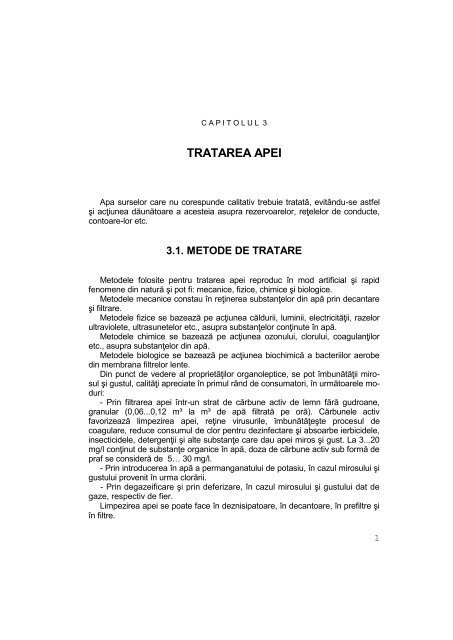
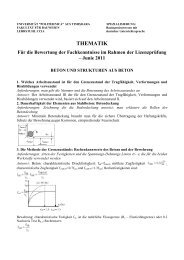
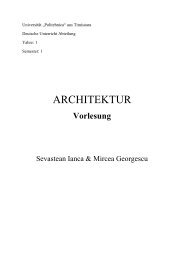
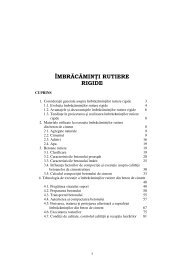
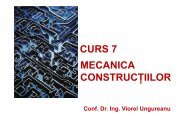
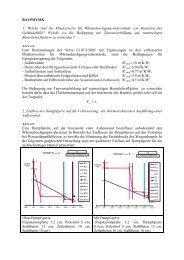
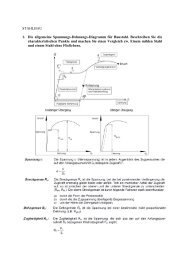
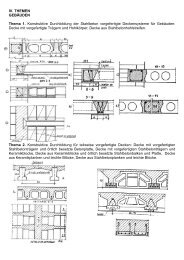
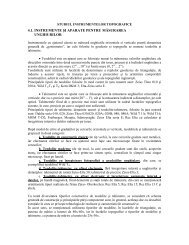
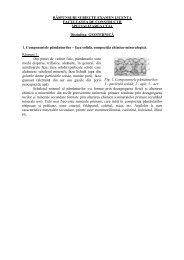
![Buletinul {tiin]ific al Universit@]ii](https://img.yumpu.com/14905381/1/190x245/buletinul-tiinific-al-universitii-politehnica-din-timioa.jpg?quality=85)
